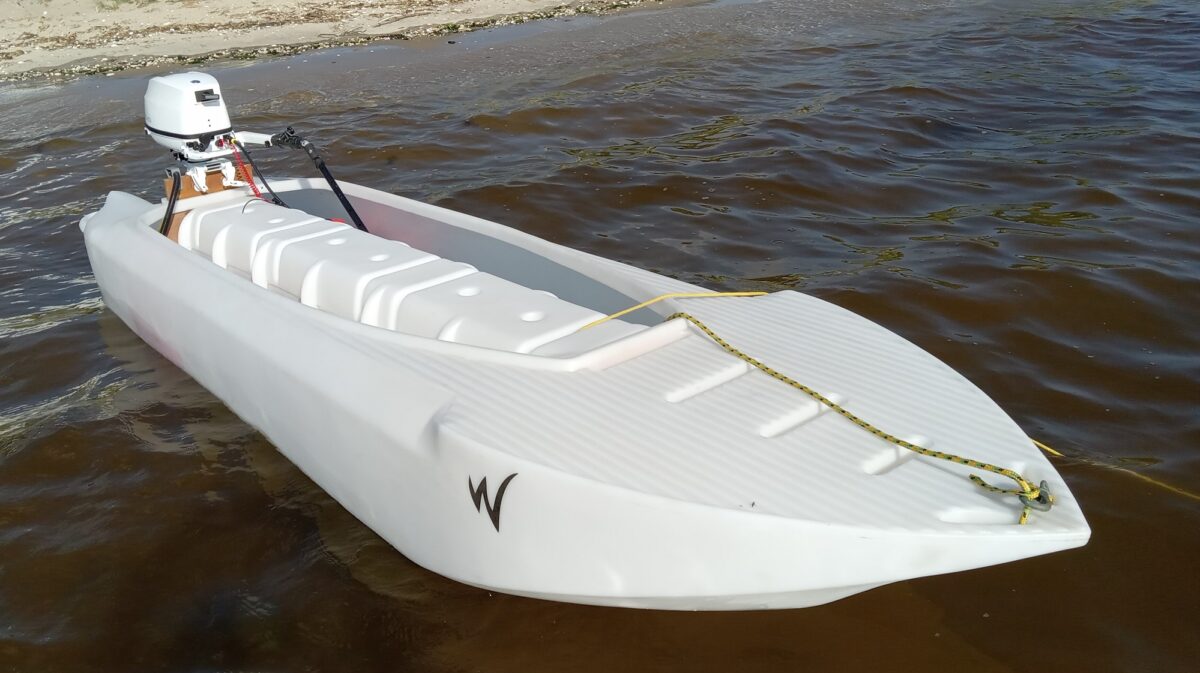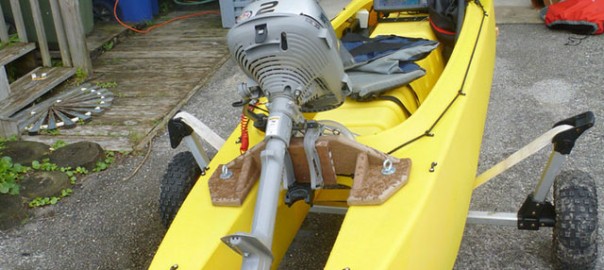When Wavewalk launched the 500 series (W500), in 2009, it became a big success overnight, and people stopped ordering the previous W300, which got canceled soon after, in 2010. Simply, the W500 design was a bigger and much better version of the W300, which didn’t have a chance to survive.
The W500 offered what no kayak could until then – Super stability coupled with zero back pain. On top of this, its onboard storage space was several times bigger than the storage space that any fishing kayak offered, and it could take a second passenger on board, providing this person wasn’t very heavy.
For a kayak that offered a load capacity of 360 lbs, the 60 lbs W500 was very lightweight. This 6:1 Load to Weight (L/W) Ratio was improved only in 2017, with the 6.5:1 L/W ratio of the S4.
In 2010, Sungjjn Kim from South Korea successfully outfitted his W500 with a 2 HP air-cooled outboard gas motor from Honda. This was a huge breakthrough in motorized kayaking, and a most significant event for Wavewalk. Before that, anglers dared outfitting their kayaks only with feeble and sluggish electric trolling motors that offered poor performance and a limited range of travel.
Soon after, Wavewalk started experimenting with Sungjin’s motorized kayak concept, and presented it to the public in articles and videos, including videos that showed it successfully driven in the ocean chop. Clients reacted positively to these ideas, and a new class of vessels was created – the cartop kayak-microskiff, an ultralight, fun, versatile and inexpensive boat that worked well as a paddle craft too.
In 2013, Kenny Tracy from Maryland outfitted his W500 with a powerful, water cooled, 6 HP outboard motor from Tohatsu. He squeezed 13 mph from that rig – faster than any motorized kayak prior to that. This was the first step in the creation of a high-performance W500.
Following Kenny’s success, and in view of the safety limitations associated with the use of such a tiny kayak with a heavy and powerful motor, Wavewalk started offering a version of the W500 called the W570, which was essentially the same model outfitted with large-size, detachable, inflatable side flotation modules. With the W570, Wavewalk also offered a lightweight, detachable spray shield.
But it became clear that adding power and accessories to the small W500 would not satisfy the market’s demand for high performance cartop microskiffs, and in 2015, Wavewalk came up with its W700 series. The W500 cost 20% less than the W700, and weighed 20 lbs less, but in the long run, these two advantages weren’t enough to compete with the bigger and better W700. In 2017 , the little W500 got further squeezed by the advent of the high performance S4, and eventually, this year, 2020, Wavewalk suspended its offering of the W500.
During the decade in which the iconic W500 was available for sale, it sold in 30 countries worldwide. People have used it for touring, diving, crabbing, fishing, shrimping, hunting, camping, bird watching, photography, positioning rowing shells before races, searching for sunken artifacts, sailing, tendering big boats and yachts, scientific research and engineering, as well as maintenance of bridges, harbors, and waterways.
The W500 offered people with severe back problems to enjoy kayaking, boating, and fishing, without suffering from any back pain or other ergonomic issues. Even people with Multiple Sclerosis (MS) benefited from its remarkable stability and comfort.
Wavewalk did not fully discontinue the W500, and the company will consider taking the W500 tooling (rotational mold) out of mothballs if an opportunity for large size orders presents itself.

